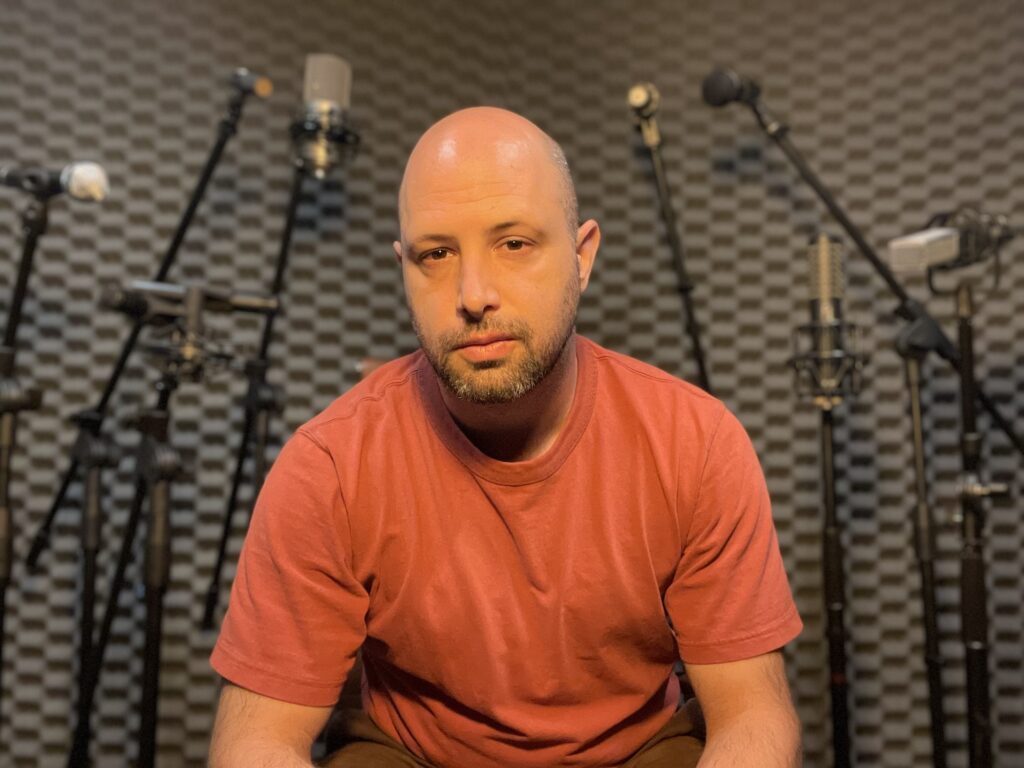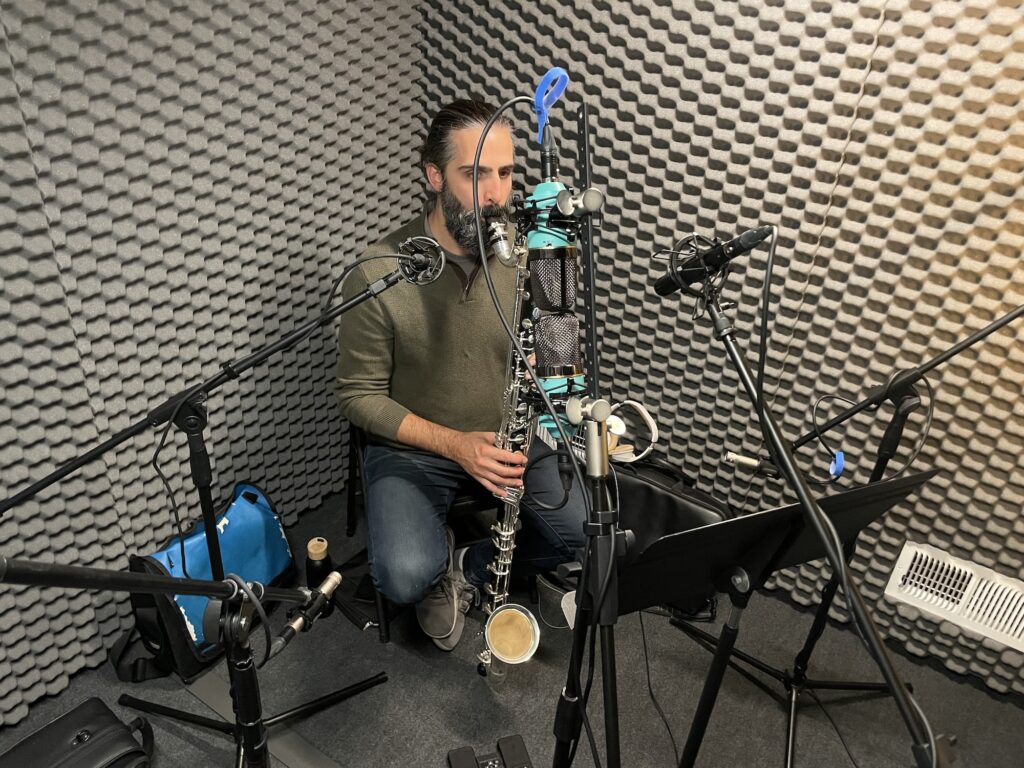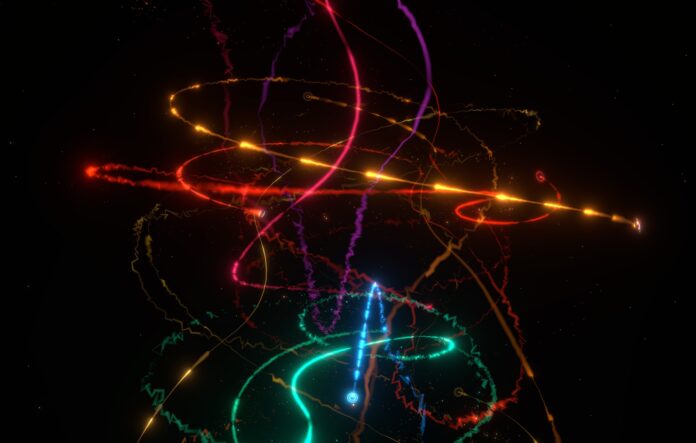In my 30-year music writing career, I can count the number of times I’ve been sent an actual, full-on virtual reality headset to review an album on one finger. With “immersive” continuing to be the buzzword in contemporary art and music circles, it was probably only a matter of time. Yet Brian Baumbusch‘s fascinating new long-form composition Polytempo Music transcends gimmicky VR hype to create a colorful, interactive musical world of its own that feels organic, essential, and alive with ideas. And he’s paving the way with a new label, Holography Records, that will help other artists work with this unique spatialized audio-visual technology as well.
Inside Polytempo Music, you don’t just feel like you’ve entered the world that longtime composer Baumbusch has created, with its gorgeously swirling animation and playful interactive features, you actually become a part of it, shaping each particular sound as you go. Colors are matched with constantly playing instruments whose volume and relation to your position you can manipulate, yielding a virtually infinite number of experiences. It’s fun, and philosophical, and visually dazzling, even for proud artistic Luddites like myself.
The standalone quality of the actual music of the piece—also available on a non-VR app and CD, for headset-free enjoyment—helps a lot. Polytempo Music is a self-contained yet densely complex work that reflects the Alameda-based composer’s minimalist-experimental roots and obsession with how music can bend time in wildly different ways. Divided into 12 sections of different moodiness and intensity (with titles like “Trifluence,” “Heliks 45,” and “Murmuration of 12” that add a poetic and descriptive dimension to the already four-dimensional work), Baumbusch’s composition engrosses and delights.
The advanced technological turn represented by Polytempo Music—all of it relatively self-taught during the pandemic, from the software coding to the advanced polytempo composition techniques—may shock those who have followed Baumbusch’s career so far.
“My life before this was building acoustic instruments,” said Baumbusch over Zoom. “I did that for a long time. I studied music in Bali, working with gamelan musicians, and had an ensemble that performed on them. It’s just funny. A lot of friends who knew me from that time thought that jumping into technology was a really weird thing for me to do, because I always had a natural sense of being connected to the acoustic sounds. I love being able to make music that’s unadulterated by amplification or other intervention. I was really, really far on the other end of this.
“I did go to Mills College for my master’s, where there were a lot of people doing electronic music and algorithmic music, so it wasn’t such an alien thing. Then I went to UC Santa Cruz for my doctoral degree, at which point there were two paths that the doctoral candidates could take. One of them was called Algorithmic Composition, and the other one was along the lines of Global Music Composition, which was the track that I was in. But I was getting exposed to a lot of algorithmic, electronically-generated music for a long time. What ultimately made me feel interested in bringing that into my own music was really just wanting to make music with polytempo structures, which was the music that I was always really interested in.”

Baumbusch made his first baby steps into the electronic music realm when he realized that using automated click tracks helped synchronize musicians as they tackled his dense scores. “I’ve done some really challenging things just by scoring in a standard staff notation, but it became frustrating to try to do that with live musicians, as capable as they may be. I decided I wanted to do something a little bit more advanced in terms of players following several different tempos. I thought, Well, what if I just have them all follow click tracks? With click tracks there was no matter of automatically looking to the percussion or conductor to keep time, or saying, ‘You’re rushing, no you’re rushing.’ When I started using software all of those arguments went away. It broke down the typical rehearsal culture.
“I did that for the first time in 2015 and then I never turned back. It started me down a path of hyper-complex polytempo structures in my music and embracing technology more. I started to really go fully digital in March 2020—literally the 20th of March 2020, right when everything shut down. I had gotten this really big commission through UC Santa Cruz for a wind ensemble piece, from a conductor that knew I worked with click tracks. Well of course they were going to cancel the performance, but the conductor said, why don’t we just record the piece remotely, using the click tracks, and we can still have jobs?”
Help us save local journalism!
Every tax-deductible donation helps us grow to cover the issues that mean the most to our community. Become a 48 Hills Hero and support the only daily progressive news source in the Bay Area.
Baumbusch ended up writing the most complex music he had ever had for that commission, and found himself more and more attracted to the idea of musicians recording their parts in his compositions separately, in isolation, even after the general pandemic quarantine periods ended. He built a sound isolation booth in his Alameda studio, which is where members of the San Francisco Contemporary Music Players recorded their parts for Polytempo Music one at a time.
“Once I had all these discrete recordings of the musicians, I thought, why am I limiting it to just being one big recording at the end of the day? What I really wanted to do was to spatialize it, to make all these polytempo structures exist in some three-dimensional way that I could then choose how I would listen to the piece,” he said.
“There’s a lot of precedence for this in contemporary music, in classics like Terry Riley’s In C. You don’t have to hear the piece in one way. Your attention can follow a lot of different things. It’s limiting, though, if you just have a stereo recording. But if you create this 3D environment that you can move around in to change how you hear the piece, that was what I wanted. That was how the whole idea came about.”
One problem: Baumbusch had never even put on a VR headset before, let along learned any kind of software coding. He reached out to people in the audio-visual world—including game audio specialist and jazz pianist Scott Looney, who understood Baumbusch’s experimental music vision—and got clued into Unity, an open-source game development program that helped people gain coding skills though creating their own games. With Polytempo Music, in a sense, he gamified the musical ensemble, learning from weekly lessons with Looney (and some help from then-newly launched AI tool ChatGPT) to build out a virtual world that assigned different instrumental lines specific colors, movements, and positions on the screen based on spatial relations to the “player.”
“I realized, even though my coding skills were limited, I understood the logic that I needed to understand,” Baumbusch said. “I just took on the role of becoming the animator. Scott did all of the other infrastructural design: when you push this button, this action occurs type of thing. But a lot of the work was animating the choreography. How is the sound moving around? It’s a 48 minutes of choreography. That became my task, to make this happen, and I just loved it. Once I started doing that, I was like, Oh, man, I found my medium as an artist here. Awesome!”

While the idea of LiDAR scanning each of the 12 SF Contemporary Music Players and having their avatars move around inside the program proved to onerous size- and budget-wise, the resulting Polytempo Music package is more than engrossing enough, lovely to look at and fun to fiddle with. (I am partial to raising the bass clarinet or harp at random moments to see how the whole thing rejiggers sonically and visually: The kaleidoscopic swirl of music pivots into whole new axial dimension, like letting your ears glide freely through the Rings of Saturn.)
The VR headset is totally not required—the Polytempo Music phone app is gorgeous—but physically moving around inside the virtual reality program was cool as heck. Baumbusch hopes to bring the overall experience to a wider audience via live performances by musicians who license his Holography platform technology, adding their own spatial audio-visual twists.
“There’s so much that could be done with this platform to broaden the live concert experience, from adding a fresh visual element to electronic DJ sets to live musicians and audiences fully interacting in a virtual space for performances. And contemporary music ensembles or composers could create their own virtual worlds as recordings—things that go way beyond simply releasing a record or having another Spotify feather in your cap,” he said.
“At a certain point in developing Polytempo Music, I started to realize, dang, I’m building an engine here just to hear this one piece of music. That’s so cool. And wouldn’t it be cool to use that engine for other things?”
POLYTEMPO MUSIC is available via Holography records and online app stores.





